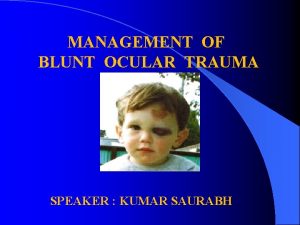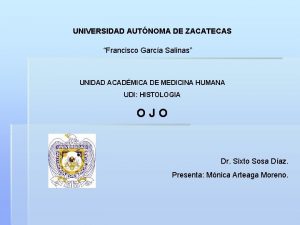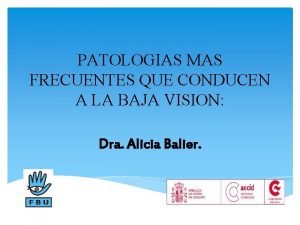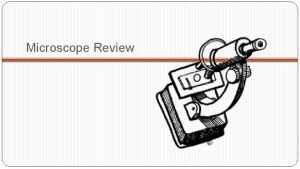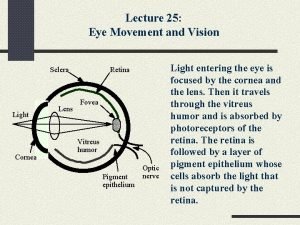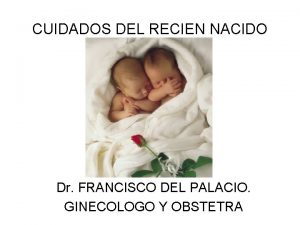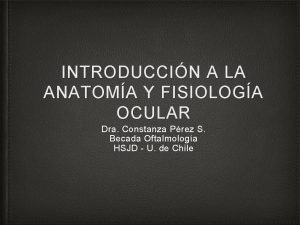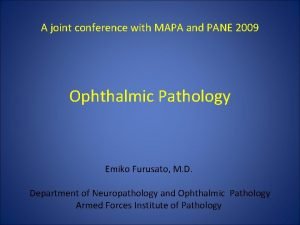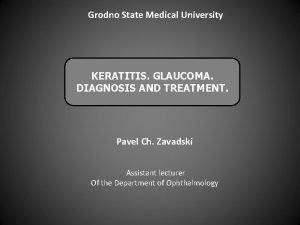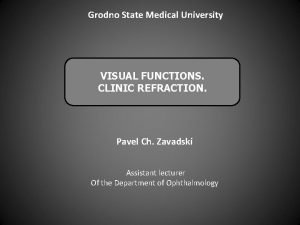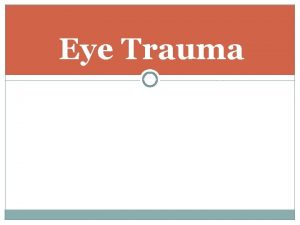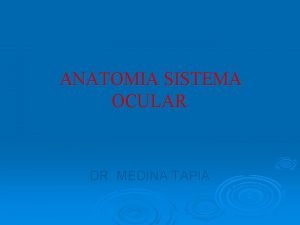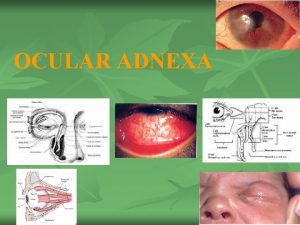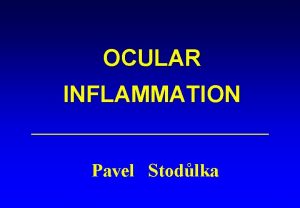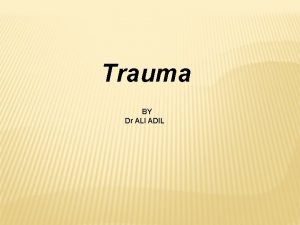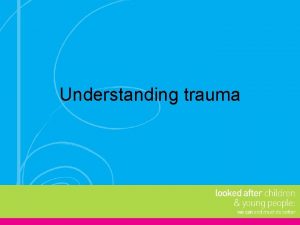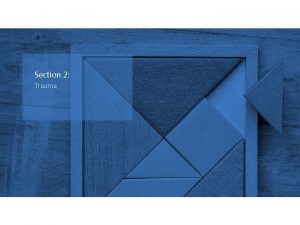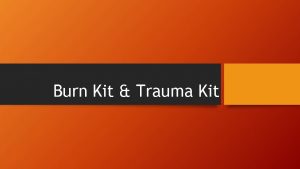Grodno State Medical University OCULAR TRAUMA DIAGNOSIS AND
























- Slides: 24

Grodno State Medical University OCULAR TRAUMA. DIAGNOSIS AND TREATMENT. Pavel Ch. Zavadski Assistant lecturer Of the Department of Ophthalmology

INTRODUCTION

CORNEAL FOREIGN BODIES Corneal foreign body is foreign material on or in the cornea, usually metal, glass, or organic material. Symptoms Foreign body sensation, Tearing, History of trauma , photophobia , pain , red eye Signs Corneal foreign body with or without rust ring, edema of the lids, conjunctiva, and cornea, foreign body can cause infection and/or tissue necrosis. Workup 1. History and document visual acuity. One or two drops of topical anesthetic may be necessary to control pain. 3. Slit-lamp Examination: If there is no evidence of perforation, evert the eyelids and inspect foreign bodies. 4. Dilate the eye and examine the vitreous and retina 5. Consider a B-scan US, CT of the orbit.

CORNEAL FOREIGN BODIES Treatment 1. Apply topical anesthetic, remove the foreign body with a spud or forceps at a slit lamp. If multiple superficial foreign bodies, its easier to remove with irrigation. 2. Remove the rust ring. This may require an ophthalmic drill. 3. Measure the size of the resultant corneal epithelial defect. 4. Treat as for corneal abrasion.

BLUNT TRAUMA Blunt impact may damage the structures at the front of the eye (the eyelid, conjunctiva, sclera, cornea, iris, and lens) and those at the back of the eye (retina and optic nerve). If a small objects hits the area the eye, itself may take most of the impact. If a large object hits the eye most of the impact is usually taken by the orbital margin. Such an impact may also result in damage to the orbit (blow-out fracture).

PENETRATING TRAUMA When a foreign body passes through the ocular coat of the eye, this will cause damage in the ocular structures, and in some cases the foreign body may also be retained in the eye. Penetrating injury of the eye represents a major threat to vision in the workplace, home and school.

LID LACERATIONS Eyelid Lacerations: Cuts to the eyelid caused by trauma Superficial Lacerations can be usually treated in the emergency room under local anesthesia.

SUBCONJUNCTIVAL HEMORRHAGE Is bleeding underneath the conjunctiva. The conjunctiva contains many small, fragile blood vessels that are easily ruptured or broken. When this happens, blood leaks into the space between the conjunctiva and sclera. Symptoms Red eye, may have mild irritation, usually asymptomatic Signs Blood underneath the conjunctiva, often in a sector of the eye. The entire view of the sclera may be obstructed by blood. Causes Valsalva (e. g. , coughing or straining), Trauma, Bleeding disorder. Workup -History: Bleeding or clotting problems? Medications (e. g. , aspirin, warfarin)? Eye rubbing, trauma, heavy lifting, Valsalva? Recurrent Subconjunctival Hemorrhage? Acute or Chronic cough (COPD)? -Check Vital signs -History of recurrence or bleeding problem -Positive Orbital signs: CT scan with and without contrast

SUBCONJUNCTIVAL HEMORRHAGE Ocular Examination: Rule out a conjunctival lesions, Check IOP, and Check extraocular motility. In traumatic cases you should rule out: -Ruptured Globe (Abnormal deep ant. Chamber, Significant SCH, Hyphema, Vitreous hemorrhage, or prolapse of uveal tissue). -Retrobulbar Hemorrhage (Exophthalmus, Increased IOP, and chemosis) -Orbital Fracture (Limited extraocular eye motility, eno- or exo-phthalmus, preiorbital crepitus, paraesthesia.

CORNEAL ABRASION Is a medical condition involving the loss of the surface epithelial layer of the eye’s cornea. It’s the most common eye injury and perhaps one of the most neglected , it occurs because of a disruption of the integrity of corneal epithelium because the corneal surface scraped away or denuded as a result of physical external forces. They usually heal without serious consequences, although deep abrasion can result in scar formation in the stroma. Examples about causes of corneal abrasion : corneal or epithelial disease (dry eye), superficial corneal injury or ocular injuries (due to foreign bodies), and contact lens wear.

CORNEAL ABRASION Most patients present with the following: Photophobia, Watering, Foreign body sensation, Gritty feeling, Pain Signs: Corneal edema Bacterial corneal ulcers Fungal, amebic, or viral corneal ulcers Uveitis Treatment: Antibiotics Ointment (Erythromycin, Ciprofloxacin) Drops (Polytrim, Fluoroqunilone) Cycloplegic agent (Cyclopentolate) for discomfort from traumatic iritis which may develop 24 -72 hours. AVOID STEROIDS. Topical NSAIDS drops (Ketorolac) for pain control. No contact lens wear

CORNEAL LACERATIONS A corneal laceration is a partial- or full-thickness injury to the cornea. A partial-thickness injury does not violate the globe of the eye (abrasion). A full-thickness injury penetrates completely through the cornea, causing a ruptured globe. Partial thickness: Signs The Ant. Chamber isn’t entered, therefore, the cornea isn’t perforated. Workup 1. Complete ocular examination 2. Seidel test. If positive then it’s a full-thickness laceration. Seidle test: is used to assess the presence of anterior chamber leakage in the cornea.

CORNEAL LACERATIONS Full thickness: We should exclude Ruptured Globe and Penetrating Ocular injury, A full-thickness injury will allow aqueous humor to escape the anterior chamber, which can result in a flat-appearing cornea, air bubbles under the cornea, or an asymmetric pupil secondary to the iris protruding through the corneal defect. with aqueous suppressants, bandage soft contact lenses, fluroquinolone drops. Alternatively, a pressure patch and twice-daily antibiotics may be used. AVOID steroids. Treatment 1. Cycloplegic (Scopolamine) and an antibiotic (Polysporin, Fluroquinolone drops) 2. If moderate to deep corneal laceration is accompanied by wound gape, it is often best to suture. 3. Tetanus toxoid for dirty wounds

LIDHYPHEMA LACERATIONS Blood in the Anterior Chamber Causes: hyphemas are frequently caused by injury “blunt trauma”, and it may partially or completely block vision. Complications: 1. hemosiderosis 2. hetrochromia 3. blood accumulation may also cause elevation of the intraocular pressure. Symptoms Pain, Blurred vision, History of blunt trauma Signs Blood in the Anterior Chamber. Gross layering or clot or both, usually visible without a slit lamp.

HYPHEMA Workup 1. History: Mechanism of injury, approximate time and day, time of visual loss, Medications (Aspirin, NSAIDs, Warfarin), History or family history of sickle cell disease/traits. 2. Complete Ocular Examination 3. CT scan of the orbit Treatment For all patients 1. Complete bed rest or hospitalization 2. Place a shield over the injured eye. Elevation of the head of the bed by approximately 45 degrees (so that the hyphema can settle out inferiorly and avoid obstruction of vision, as well as to facilitate resolution 3. Atropine 4. Mild analgesics 5. Topical steroids drops (Traumatic iritis develop 2 -3 days) 6. NO aspirin or NSAIDs

SUBLUXATION /DISLOCATION OF THE LENS Definition: Subluxation: Partial disruption of the zonular fibers; the lens is decentered but remains partially in the pupillary aperture Dislocation: Complete disruption of the zonular fibers; the lens is displaced out of the papillary aperture. Causes 1. Trauma most common cause 2. Marfan Syndrome 3. Homocystinuria Symptoms Decreased vision, double vision that persists when covering one eye (monocular diplopia) Sign Decentered or displaced lens, . Marked astigmatism, Cataract, Angleclosure glaucoma as a result of pupillary block, acquired high myopia, viterous in the ant. Chamber, asymmetry of the ant. Chamber depth Treatment In dislocation; surgical intervene

TRAUMATIC CATARACT Traumatic cataracts occur secondary to blunt or penetrating ocular trauma. Infrared energy , and ionizing radiation are other rare causes of traumatic cataracts. Cataracts caused by blunt trauma classically form stellate- or rosette-shaped. penetrating trauma with disruption of lens capsule forms cortical changes. History Mechanism of injury - Sharp versus blunt Past ocular history - Previous eye surgery, glaucoma, retinal detachment, diabetic eye disease.

BLOWOUT FRACTURE A blowout fracture is a fracture of the walls or floor of the orbit. Intraorbital material may be pushed out into one of the paranasal sinuses. This is most commonly caused by blunt trauma of the head - Symptoms: Pain (especially on attempted vertical eye movement) Local tenderness Binocular double vision Eyelid swelling And creptius after nasal blowing Sign: damage to the orbit itself is suspected if the following signs are present : Emphysema (air under the skin with crackles when pressed) derived from the fractured sinus. Parasthesia below the orbital rim suggesting infraorbital nerve damage Limitation of eye movement , particularly on upgaze and downgaze , due to tethering of the inferior rectus muscle.

COMMOTIO RETINAE Concussion of the retina that may produce a milky edema in the posterior pole that clears up after a few days. Symptoms Decreased vision or asymptomatic, history of recent ocular trauma Signs Confluent area of retinal whitening Workup Complete ophthalmic examination, including dilated fundus examination. Scleral depression is performed excep when a hyphema, or iritis is present Treatment No treatment is required because this condition usually clears without therapy

TRAUMATIC RETINAL DETACHMENT Retinal detachment refers to separation of the inner layers of the retina from the underlying retinal pigment epithelium (RPE, choroid). Emergency Department treatment of retinal detachment consists of evaluating the patient and treating any unstable vital signs, preparing the patient for possible emergency surgery.

TRAUMATIC RETINAL DETACHMENT Most chemical substances that come in contact with the conjunctiva or cornea cause little harm. The chief danger comes from alkali-containing compounds found in household cleaning fluids, fertilizers and pesticides. They erode and opacify the cornea. Acid-containing compounds (battery fluid, chemistry labs) are somewhat less dangerous. There are no antidotes to these chemicals. The best you can do is to dilute them immediately with plain water. The resultant reaction of the tissue causes the damage.

CHEMICAL BURN Treatment should be instituted immediately, even before testing vision. Emergency treatment: 1 -copious irrigation of the eyes, preferably with saline or ringer lactate. Don’t use acidic solutions to neutralize alkalis or vice versa. Pull down the lower eyelid and evert the upper eyelid to irrigate the fornices 2 -irrigation should be continued until neutral PH is reached. The volume of irrigation fluid required to reach neutral PH varies with the chemical and the duration of the chemical exposure For mild to moderate burns (during and after irrigation): -cycloplegic -topical antibiotic -oral pain medication -if increase IOP use drugs to reduce it (acetazolamide, methazolamide add b blocker if additional IOP control is required) -frequent use of preservative free artificial tear.

CHEMICAL BURN For severe burns (Treatment after irrigation): Admission to the hospital Lysis of conjunctival adhesion Debride necrotic tissue Topical antibiotic Topical steroid Antiglaucoma medication if the IOP is increased or cant be determined Frequent use of preservative free artificial tear Other consideration: Therapeutic contact lenses, collagen, amniotic membrane transplant IV ascorbate and citrate for alkali burns If any melting of the cornea occurs, collagenase inhibitors may be used If the melting progresses an emergency patch graft or corneal transplat may be necessary.

Thank You For Your Attention
 Ocular trauma score
Ocular trauma score Nursing process assessment
Nursing process assessment Medical diagnosis and nursing diagnosis difference
Medical diagnosis and nursing diagnosis difference Types of nursing diagnosis
Types of nursing diagnosis Objectives of nursing process
Objectives of nursing process Perbedaan diagnosis gizi dan diagnosis medis
Perbedaan diagnosis gizi dan diagnosis medis Stavropol state medical university
Stavropol state medical university Osh state medical university logo
Osh state medical university logo Www.dfps.state.tx.us/training/trauma informed care/
Www.dfps.state.tx.us/training/trauma informed care/ Epitelio conjuntiva ocular
Epitelio conjuntiva ocular Premier formula for ocular nutrition
Premier formula for ocular nutrition Vagabundeo ocular
Vagabundeo ocular Tube in microscope
Tube in microscope Function fine adjustment knob
Function fine adjustment knob Vestibulo ocular reflex
Vestibulo ocular reflex Moderate persistent asthma
Moderate persistent asthma Brepharitis
Brepharitis Ocular histoplasmosis triad
Ocular histoplasmosis triad Salud ocular his
Salud ocular his Importancia de la profilaxis ocular del recién nacido
Importancia de la profilaxis ocular del recién nacido Esterman efficiency score 92
Esterman efficiency score 92 The arm connects the body tube
The arm connects the body tube Globo ocular
Globo ocular Ocular lens microscope
Ocular lens microscope Mapa ocular
Mapa ocular
